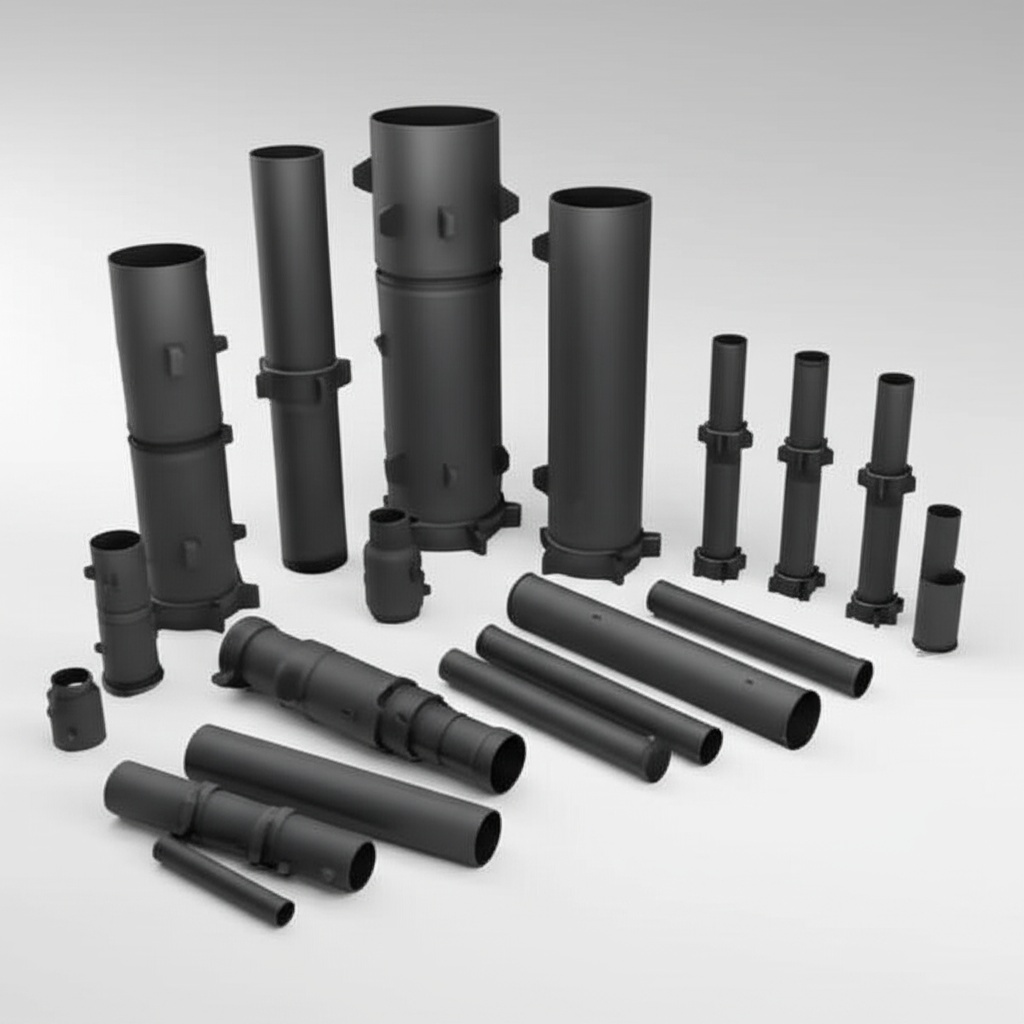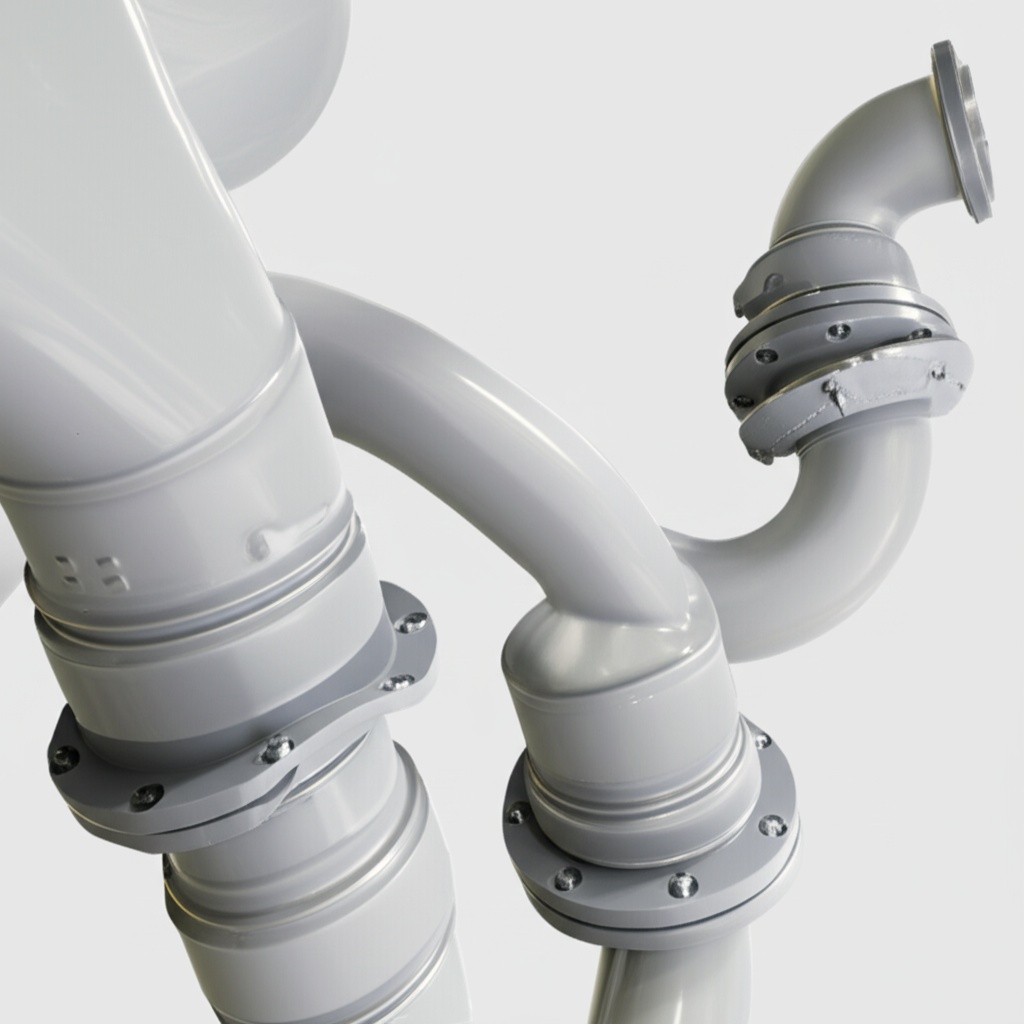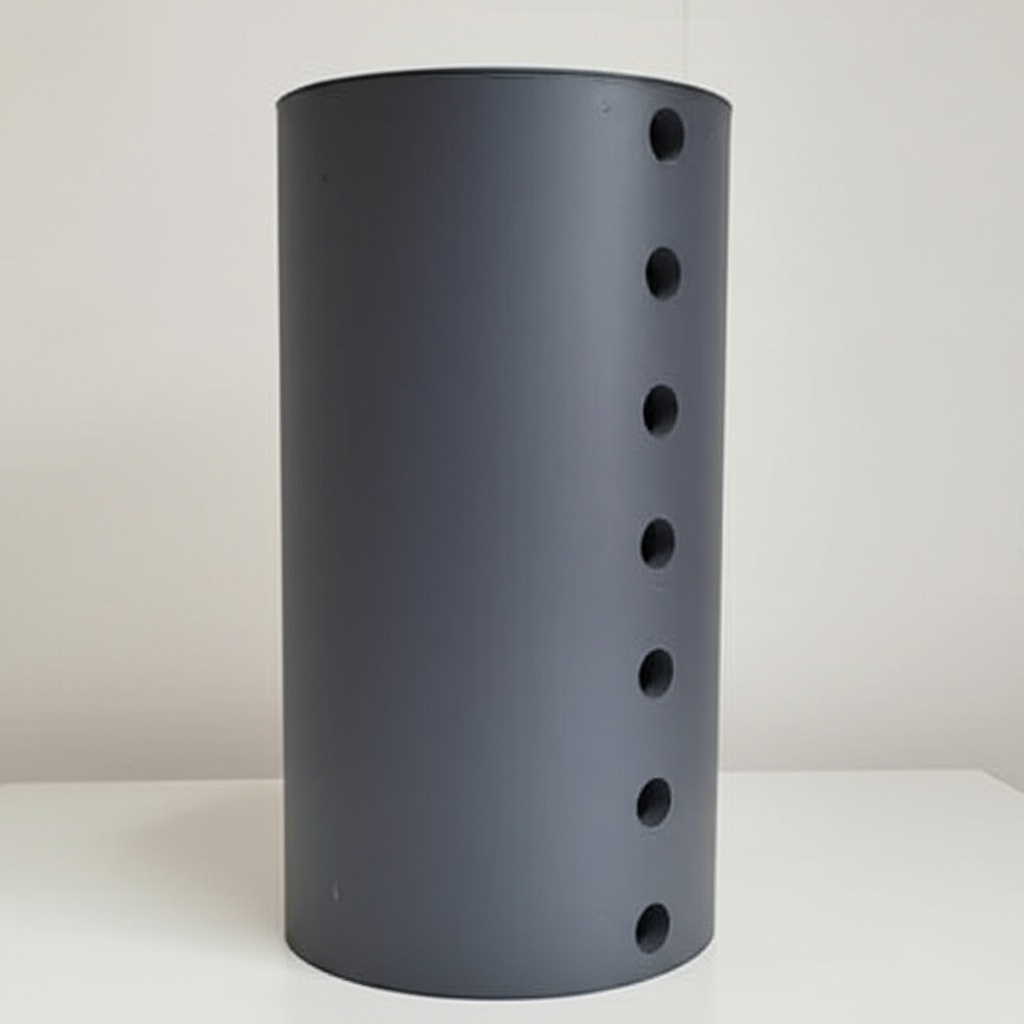SiC Cutting Tools: Precision for All Industries

Share
SiC Cutting Tools: Precision for All Industries
Introduction – What are Custom Silicon Carbide Cutting Tools and Why Are They Essential?
In the ever-evolving landscape of advanced manufacturing and high-performance industrial applications, the demand for materials that can withstand extreme conditions while delivering unparalleled precision is paramount. Silicon Carbide (SiC) cutting tools have emerged as a cornerstone technology, offering a unique combination of hardness, wear resistance, and thermal stability. These tools are not mere off-the-shelf commodities; they are often highly engineered components tailored to specific machining tasks and material challenges. Custom silicon carbide cutting tools are specifically designed and manufactured to meet the unique requirements of demanding applications where standard tooling falls short. Their essential nature stems from their ability to machine difficult materials, extend tool life significantly, and maintain dimensional accuracy under aggressive cutting parameters. This translates to enhanced productivity, reduced downtime, and superior quality of finished parts, making them indispensable for industries striving for a competitive edge. The inherent properties of SiC, such as its high thermal conductivity and low thermal expansion, allow for efficient heat dissipation during cutting, minimizing thermal damage to both the tool and the workpiece. As industries from aerospace to automotive push the boundaries of material science, the need for robust and precise cutting solutions like custom SiC tools becomes increasingly critical for innovation and efficiency.
The journey of silicon carbide from a laboratory curiosity to an industrial mainstay is a testament to its exceptional characteristics. For cutting tool applications, SiC offers a significant leap in performance over traditional materials like high-speed steel or even some cemented carbides, especially when machining abrasive non-ferrous alloys, composites, and ceramics. The customization aspect allows manufacturers to optimize tool geometry, edge preparation, and even the specific grade of SiC to match the intricacies of their operations. This level of tailoring ensures maximum performance, making custom SiC cutting tools a strategic investment for any high-stakes manufacturing environment.
Main Applications – How SiC Cutting Tools Revolutionize Key Industries
The superior properties of silicon carbide cutting tools make them invaluable across a diverse range of industries. Their ability to machine hard and abrasive materials, operate at high speeds, and resist wear in harsh environments translates into significant operational advantages.
- Semiconductor Manufacturing: SiC components, including cutting tools (though less for direct wafer cutting, more for machining SiC components themselves or support structures), are used where ultra-high purity, precision, and resistance to corrosive environments are critical. Precision machining of ceramic parts used in wafer processing equipment benefits from SiC tooling.
- Automotive: In the automotive sector, SiC cutting tools are employed for machining abrasive aluminum alloys, metal matrix composites (MMCs), and high-silicon aluminum. Applications include engine components, brake discs, and structural parts where wear resistance and surface finish are crucial. The rise of electric vehicles (EVs) also presents new opportunities, with SiC power electronics requiring precise machining of associated components.
- Aerospace: The aerospace industry relies on SiC cutting tools for machining lightweight, high-strength composites, superalloys, and ceramic matrix composites (CMCs). These materials are essential for aircraft structures, engine components, and thermal protection systems, where precision and reliability are non-negotiable.
- Power Electronics: While SiC is a key semiconductor material in power devices, tooling made from SiC can be used in the manufacturing processes of associated mechanical components, heat sinks, and packaging, particularly where non-magnetic or electrically insulating tools are beneficial.
- Renewable Energy: Components for wind turbines, solar panel manufacturing equipment, and geothermal energy systems often involve abrasive materials or require long-lasting, precise machining solutions that SiC cutting tools can provide.
- Metallurgy: In metallurgical processes, SiC tools can be used for cutting and shaping refractory materials, graphite electrodes, and other hard, abrasive substances encountered in foundries and metal processing plants.
- Defense: The defense sector utilizes SiC cutting tools for manufacturing components from advanced ceramics, composites, and hardened alloys used in armor, munitions, and high-performance vehicles.
- Chemical Processing: While direct cutting applications might be limited, the machining of components for chemical processing equipment (e.g., pump parts, valve seats made from engineering plastics or composites) can benefit from the chemical inertness and wear resistance of SiC tools.
- LED Manufacturing: Precision dicing and shaping of sapphire and SiC substrates for LED production can involve specialized cutting technologies where SiC’s properties could be advantageous for tooling or fixtures.
- Industrial Machinery: Manufacturers of industrial equipment use SiC cutting tools for producing durable parts from cast iron, hardened steels, and other challenging materials, enhancing the longevity and performance of machinery.
- Oil and Gas: Downhole drilling tools, pump components, and valve parts exposed to abrasive and corrosive environments in the oil and gas industry can be manufactured or finished using SiC cutting tools for extended service life.
- Medical Devices: The machining of biocompatible ceramics, titanium alloys, and specialized polymers for medical implants and surgical instruments demands high precision and excellent surface finishes, areas where SiC cutting tools can excel.
- Rail Transportation: Manufacturing components for braking systems, engine parts, and track infrastructure involves materials that can be effectively machined using robust SiC cutting tools.
- Nuclear Energy: Machining of graphite moderator blocks, ceramic fuel components, and other specialized materials in the nuclear industry requires tools that offer precision and minimal contamination, for which SiC can be a suitable candidate.
Why Choose Custom Silicon Carbide Cutting Tools?
Opting for custom silicon carbide cutting tools over standard alternatives offers a multitude of advantages, particularly when tackling challenging materials or aiming for optimal machining performance. Customization allows for designs tailored to specific applications, maximizing efficiency and component quality.
Key benefits include:
- Exceptional Hardness and Wear Resistance: Silicon carbide is one of the hardest commercially available ceramic materials, second only to diamond. This translates to significantly longer tool life, especially when machining highly abrasive materials like high-silicon aluminum, composites, and ceramics. Reduced wear means fewer tool changes, less downtime, and consistent part quality.
- Superior Thermal Stability and High-Temperature Performance: SiC cutting tools retain their hardness and strength at elevated temperatures. This allows for higher cutting speeds and feeds, leading to increased material removal rates without compromising tool integrity or causing thermal damage to the workpiece. Their high thermal conductivity also helps dissipate heat from the cutting zone effectively.
- Chemical Inertness: Silicon carbide exhibits excellent resistance to chemical attack from acids, alkalis, and molten metals. This makes SiC tools suitable for machining reactive materials and for use in environments where chemical corrosion could degrade other tool materials.
- Lightweight Nature (for certain applications): While hardness is key, the relatively lower density of SiC compared to some tungsten carbide grades can be beneficial in high-speed rotating applications, reducing inertial forces.
- Achievable Precision: Custom SiC tools can be manufactured to very tight tolerances with excellent edge sharpness and surface finishes. This is critical for applications demanding high-precision components with specific surface integrity requirements.
- Optimized Tool Geometry: Customization allows for the design of application-specific geometries, including rake angles, clearance angles, cutting edge preparation (e.g., honing, chamfering), and chip breaker designs. This optimization ensures efficient chip formation, reduced cutting forces, and improved surface finish.
- Material Grade Selection: Different manufacturing processes for SiC (e.g., sintered, reaction-bonded) yield materials with varying properties. Customization allows for the selection of the most appropriate SiC grade for a specific cutting task, balancing hardness, toughness, and cost.
- Reduced Production Costs: Although custom tools may have a higher upfront cost, their extended life, ability to machine at higher rates, and reduction in scrap rates often lead to lower overall production costs per part.
When considering highly specialized machining tasks, the ability to tailor a cutting tool to the exact needs of an operation provides a significant competitive advantage. For businesses looking to push the boundaries of manufacturing, customizing SiC solutions is not just an option, but a strategic imperative.
Recommended SiC Grades and Compositions for Cutting Tools
The performance of a silicon carbide cutting tool is heavily influenced by its specific grade and composition, which are determined by the manufacturing process. Selecting the right grade is crucial for optimizing tool life, cutting efficiency, and workpiece quality.
Common types of SiC used or relevant to cutting tool applications include:
| SiC Grade | Manufacturing Process | Key Characteristics for Cutting Applications | Typical Cutting Applications |
|---|---|---|---|
| Sintered Silicon Carbide (SSC / SSiC) | Solid-state sintering of fine SiC powder at high temperatures (2000-2200°C), often with non-oxide sintering aids (e.g., boron, carbon). | Very high hardness, excellent wear resistance, good strength, high thermal conductivity, excellent chemical resistance. Fine grain structure allows for sharp cutting edges. | Machining non-ferrous metals (Al alloys, brass, bronze), abrasive plastics, composites (GFRP, CFRP), graphite, green ceramics. Finishing operations requiring high precision and surface quality. |
| Reaction-Bonded Silicon Carbide (RBSC / SiSiC) | Infiltration of molten silicon into a porous preform of SiC grains and carbon. The silicon reacts with carbon to form new SiC, bonding the original grains. Contains some free silicon (typically 8-15%). | Good wear resistance, high thermal conductivity, excellent thermal shock resistance, relatively lower cost than SSC. Presence of free silicon can affect hardness slightly compared to SSC but improves toughness. | Machining abrasive materials where extreme hardness is not the sole criterion and thermal shock is a concern. Less common for high-precision cutting edges compared to SSC but suitable for wear parts associated with cutting processes or more robust cutting applications. |
| Nitride-Bonded Silicon Carbide (NBSC) | SiC grains bonded by a silicon nitride (Si3N4) phase. | Good wear resistance, high strength, excellent thermal shock resistance, and good resistance to molten metals. | Often used in metallurgical applications or high-temperature environments. For cutting, it might be considered for specialized applications involving high thermal cycling or contact with reactive materials. |
| Hot-Pressed Silicon Carbide (HPSC) | Densification of SiC powder under high temperature and pressure. | Extremely high density, superior hardness, and strength. Can achieve very fine grain structures. | High-performance cutting applications requiring the utmost in wear resistance and strength. Often more expensive due to the manufacturing process. Suitable for demanding tasks in aerospace and advanced material machining. |
| CVD Silicon Carbide (Chemical Vapor Deposition) | Deposition of SiC from gas precursors, resulting in ultra-high purity SiC. | Extremely high purity, theoretical density, excellent wear and corrosion resistance. Can be applied as a coating or form bulk material. | Used as a coating on other tool materials to enhance surface properties or for specialized solid SiC tools in ultra-high purity environments like semiconductor processing. Less common as a bulk cutting tool material due to cost but valuable for edge enhancement. |
The choice of SiC grade depends on a careful analysis of the workpiece material, cutting parameters, required tool life, surface finish specifications, and economic considerations. For instance, SSiC is often preferred for its fine grain structure, enabling very sharp and durable cutting edges suitable for precision machining of non-ferrous alloys and composites. RBSC might be chosen for applications requiring good thermal shock resistance and where the presence of some free silicon is not detrimental. Consulting with an experienced SiC supplier is crucial to selecting the optimal grade for a specific cutting tool application.
Design Considerations for SiC Cutting Tools
Designing effective silicon carbide cutting tools requires a deep understanding of the material’s unique properties, particularly its hardness and brittleness, alongside the specific demands of the machining application. Careful design can maximize performance, extend tool life, and prevent premature failure.
Key design considerations include:
- Tool Geometry:
- Rake Angle (Positive, Negative, Neutral): Negative rake angles are often preferred for SiC tools when machining hard materials as they provide a stronger cutting edge. However, for softer non-ferrous materials or composites, neutral or slightly positive rake angles might improve shearing action and reduce cutting forces.
- Clearance Angle: Adequate clearance is necessary to prevent rubbing between the tool flank and the machined surface. However, excessive clearance can weaken the cutting edge. This needs to be optimized based on the material being cut.
- Cutting Edge Angle (Lead Angle): Affects chip thickness, cutting forces, and tool entry/exit conditions.
- Nose Radius: A larger nose radius generally provides a stronger cutting edge and can improve surface finish, but it may also increase cutting forces and the tendency for vibration.
- Edge Preparation:
- Honing: A slight rounding of the cutting edge (e.g., ER hone, waterfall hone) significantly increases its strength and prevents micro-chipping, which is crucial for brittle SiC. The size and type of hone depend on the application (heavy-duty vs. finishing).
- Chamfer (K-land): A small flat ground on the cutting edge, often at a negative angle, to further strengthen it, particularly for interrupted cuts or machining very abrasive materials.
- Chip Breaker Design: Effective chip control is vital. Custom-designed chip breakers (grooves or features on the rake face) can help break chips into manageable sizes, preventing entanglement and improving surface finish. The geometry of chip breakers for SiC tools must be carefully considered to avoid stress concentrations.
- Tool Holder and Clamping: Due to SiC’s brittleness, secure and rigid clamping is essential to minimize vibration, which can lead to chipping or catastrophic tool failure. The interface between the SiC insert (if applicable) and the tool holder must be precise.
- Minimizing Stress Concentrators: Sharp internal corners or abrupt changes in cross-section should be avoided in the tool design as these can act as stress concentration points, leading to fracture. Generous radii are preferred.
- Wall Thickness and Aspect Ratios: For solid SiC tools or features, minimum wall thicknesses and practical aspect ratios must be respected to ensure structural integrity during manufacturing and use.
- Thermal Management Features: While SiC has excellent thermal conductivity, design features that aid in coolant delivery to the cutting edge can be beneficial, especially in high-speed operations.
- Manufacturability: The design must be compatible with the capabilities of SiC manufacturing processes (e.g., grinding, EDM for some types). Complex geometries can significantly increase manufacturing costs and lead times.
- Brazing/Joining (for tipped tools): If SiC tips are brazed onto a tougher tool body (e.g., steel or carbide), the brazing process and joint design are critical to withstand cutting forces and thermal stresses. Differential thermal expansion must be managed.
Collaborating with a knowledgeable SiC manufacturer like Sicarb Tech, which has deep expertise in material science and application engineering, is invaluable. Their experience can guide the design process, ensuring that the custom SiC cutting tools are optimized for performance, durability, and cost-effectiveness. They understand the nuances of silicon carbide production and customization.
Tolerance, Surface Finish & Dimensional Accuracy in SiC Cutting Tools
Silicon carbide’s extreme hardness, while beneficial for wear resistance, presents challenges in achieving tight tolerances and fine surface finishes on the tools themselves. However, advanced grinding, lapping, and polishing techniques allow for the manufacture of SiC cutting tools with high precision.
- Achievable Tolerances:
- Dimensional Tolerances: For critical dimensions such as insert size (IC, thickness), corner radius, and hole diameter (if applicable), tolerances in the range of ±0.005 mm to ±0.025 mm (±0.0002″ to ±0.001″) are often achievable, depending on the tool’s complexity and size. Highly specialized applications might demand even tighter tolerances, which can increase manufacturing costs.
- Geometric Tolerances: Parameters like parallelism, perpendicularity, and concentricity can also be controlled to high precision, essential for ensuring proper tool seating and cutting performance.
- Surface Finish:
- Cutting Edges: The sharpness and smoothness of the cutting edge are paramount. Lapping and honing processes can produce very sharp edges with minimal defects. Surface finishes on the rake and flank faces influence friction, chip flow, and built-up edge formation.
- Rake Face/Flank Face: Surface finishes (Ra – average roughness) on these active faces can be achieved down to 0.1 µm or better through fine grinding and polishing. A smoother surface generally reduces friction and can improve workpiece surface quality.
- Tool Body: Non-critical surfaces may have less stringent finish requirements to manage costs.
- Dimensional Accuracy and Stability:
- SiC exhibits excellent dimensional stability over a wide temperature range due to its low coefficient of thermal expansion. This helps maintain accuracy during high-temperature machining operations.
- The inherent stiffness (high Young’s modulus) of SiC means that the tool will deform very little under cutting forces, contributing to dimensional accuracy of the machined part.
- Inspection and Quality Control:
- Manufacturing high-precision SiC tools requires sophisticated metrology equipment, including optical comparators, vision systems, CMMs (Coordinate Measuring Machines), and surface profilometers to verify dimensions, geometry, and surface finish.
- Edge preparation (hones, chamfers) often requires microscopic inspection to ensure consistency.
Achieving the desired tolerances and surface finishes on SiC cutting tools involves specialized machining processes like diamond grinding, lapping with diamond slurries, and sometimes Electrical Discharge Machining (EDM) for conductive SiC grades (like RBSC) or for creating intricate features. The skill and experience of the manufacturer are critical in delivering tools that meet stringent specifications. Investment in advanced finishing equipment and rigorous quality control protocols are hallmarks of a capable SiC cutting tool supplier.
Post-Processing Needs for SiC Cutting Tools
After the primary shaping of silicon carbide cutting tools, various post-processing steps are often necessary to achieve the final desired properties, geometry, and performance characteristics. These steps are critical for enhancing tool life, cutting efficiency, and workpiece quality.
- Precision Grinding: This is the most common and crucial post-processing step. Diamond grinding wheels are used due to SiC’s extreme hardness. Grinding is employed to:
- Achieve final dimensions and tolerances.
- Create precise cutting angles (rake, clearance, lead).
- Sharpen cutting edges.
- Generate specific features like nose radii and chip breakers.
- Ensure flatness and parallelism of seating surfaces for inserts.
- Lapping and Polishing: For applications requiring exceptionally smooth surface finishes (e.g., on rake and flank faces to reduce friction and BUE) or ultra-sharp cutting edges, lapping with fine diamond slurries and polishing techniques are employed. This can significantly improve the quality of the machined surface and extend tool life in certain applications.
- Edge Preparation (Honing/Chamfering): As mentioned in design considerations, this is a vital post-processing step.
- Honing: Creating a controlled radius on the cutting edge (e.g., using brush honing, drag finishing, or specialized micro-blasting) to strengthen it and prevent premature chipping.
- Chamfering (T-landing): Grinding a small, often negative, land on the cutting edge for added strength, particularly for interrupted cuts or very abrasive materials.
- Coatings (PVD/CVD): While SiC itself is very hard, thin-film coatings can sometimes be applied to further enhance specific properties:
- Diamond Coatings (e.g., PCD, DLC): Can provide even greater surface hardness and lubricity, especially beneficial when machining non-ferrous materials and composites. Adhesion to SiC can be challenging but offers performance benefits.
- Other Ceramic Coatings (e.g., TiAlN, AlCrN): May be considered for specific applications to modify frictional characteristics or improve resistance to certain types of wear, though less common on solid SiC tools than on carbide tools. The primary benefit of SiC is its bulk properties.
- Cleaning: Thorough cleaning is essential to remove any residues from grinding, lapping, or other processing steps. This ensures that the tool is free from contaminants that could affect performance or workpiece quality. Ultrasonic cleaning with appropriate solutions is often used.
- Stress Relieving: In some cases, particularly after aggressive grinding or complex shaping, a low-temperature annealing or stress-relieving heat treatment might be performed to reduce internal stresses, although SiC’s high thermal stability makes this less common than with metals.
- Inspection and Quality Control: Rigorous inspection after each post-processing step is critical. This includes dimensional checks, geometric tolerance verification, surface finish measurement, and microscopic examination of cutting edges.
The extent and nature of post-processing depend heavily on the specific SiC grade, the complexity of the tool design, and the application requirements. Each step adds to the cost and lead time but is often indispensable for achieving the high performance expected from custom silicon carbide cutting tools.
Common Challenges in SiC Cutting Tool Application and Mitigation
While silicon carbide cutting tools offer remarkable advantages, users may encounter certain challenges in their application. Understanding these potential issues and implementing mitigation strategies is key to unlocking their full potential.
| Challenge | Description | Mitigation Strategies |
|---|---|---|
| Brittleness / Low Fracture Toughness | SiC is a ceramic and thus more brittle than metallic tool materials like HSS or even many cemented carbides. This can lead to chipping or catastrophic failure under impact loads, excessive vibration, or improper handling. |
|
| Sensitivity to Vibration (Chatter) | Vibrations during machining can lead to premature edge chipping or poor surface finish. SiC’s stiffness can sometimes make it susceptible if the overall machine-tool-workpiece system is not rigid. |
|
| Difficulty in Machining SiC Itself (Tool Manufacturing) | The extreme hardness of SiC makes manufacturing the tools themselves challenging and costly, requiring specialized diamond grinding and processing. This is more a manufacturer’s challenge but impacts tool cost and availability. |
|
| Thermal Shock Sensitivity | While SiC has good thermal conductivity, rapid and extreme temperature fluctuations (e.g., intermittent coolant application in heavy cuts) can potentially lead to thermal shock and cracking in some grades. |
|
| Proper Application Knowledge Required | Achieving optimal performance requires understanding the specific cutting characteristics of SiC tools and how they interact with different workpiece materials. Incorrect application can lead to poor results. |
|
| Higher Initial Tool Cost | Custom SiC cutting tools generally have a higher upfront cost compared to conventional tools due to raw material costs |

About the Author: Sicarb Tech
We provide clear and reliable insights into silicon carbide materials, component manufacturing, application technologies, and global market trends. Our content reflects industry expertise, practical experience, and a commitment to helping readers understand the evolving SiC landscape.



